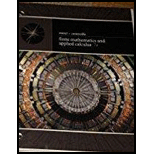
Concept explainers
Day Trading Day traders typically buy and sell stocks (or other investment instruments) during the trading day and sell all investments by the end of the day. Exercises 63 and 64 are based on the following table, which shows the closing prices on September 22, 2015, of 12 stocks selected by your broker, Prudence Swift, as well as the change that day.22
| Tech Stocks | Close | Change |
| AAPL (Apple) | $113.40 | –1.81 |
| ADBE (Adobe Systems) | $84.66 | 1.34 |
| EBAY (eBay) | $25.61 | –0.31 |
| MSFT (Microsoft) | $3.90 | –0.21 |
| S (Sprint) | $4.40 | 0.02 |
| WIFI (Boingo Wireless) | $8.51 | 0.56 |
| Non-Tech Stocks | ||
| ANF (Abercrombie & Fitch | $21.81 | –0.02 |
| B (Boeing) | $133.99 | –2.03 |
| F (Ford Motor Co.) | $13.91 | –0.40 |
| GE (General Electric) | $25.10 | 0.01 |
| GIS (General Mills) | $57.12 | 0.33 |
| JNJ (Johnson & Johnson) | $93.26 | 0.13 |
OnthemorningofSeptember22,2015, Swift advised you to purchase a collection of three tech stocks and two non-tech stocks, all chosen at random from those listed in the table. You were to sell all the stocks at the end of the trading day. a. How many possible collections are possible?
a. How many possible collections are possible?
b. You tend to have bad luck with stocks—they usually start going down the moment you buy them. How many of the collections in part (a) consist entirely of stocks that declined in value by the end of the day?
c. Using the answers to parts (a) and (b), what would you say your chances were of choosing a collection consisting entirely of stocks that declined in value by the end of the day?
Trending nowThis is a popular solution!

Chapter 7 Solutions
Finite Mathematics and Application Calculus (Looseleaf) - Text Only
- Draw the asymptotes (if there are any). Then plot two points on each piece of the graph.arrow_forwardCancel Done RESET Suppose that R(x) is a polynomial of degree 7 whose coefficients are real numbers. Also, suppose that R(x) has the following zeros. -1-4i, -3i, 5+i Answer the following. (a) Find another zero of R(x). ☐ | | | | |│ | | | -1 བ ¢ Live Adjust Filters Croparrow_forwardSuppose that R (x) is a polynomial of degree 7 whose coefficients are real numbers. Also, suppose that R (x) has the following zeros. -1-4i, -3i, 5+i Answer the following. (c) What is the maximum number of nonreal zeros that R (x) can have? ☐arrow_forward
- Suppose that R (x) is a polynomial of degree 7 whose coefficients are real numbers. Also, suppose that R (x) has the following zeros. -1-4i, -3i, 5+i Answer the following. (b) What is the maximum number of real zeros that R (x) can have? ☐arrow_forwardi need help please dont use chat gptarrow_forward3.1 Limits 1. If lim f(x)=-6 and lim f(x)=5, then lim f(x). Explain your choice. x+3° x+3* x+3 (a) Is 5 (c) Does not exist (b) is 6 (d) is infinitearrow_forward
- 1 pts Let F and G be vector fields such that ▼ × F(0, 0, 0) = (0.76, -9.78, 3.29), G(0, 0, 0) = (−3.99, 6.15, 2.94), and G is irrotational. Then sin(5V (F × G)) at (0, 0, 0) is Question 1 -0.246 0.072 -0.934 0.478 -0.914 -0.855 0.710 0.262 .arrow_forward2. Answer the following questions. (A) [50%] Given the vector field F(x, y, z) = (x²y, e", yz²), verify the differential identity Vx (VF) V(V •F) - V²F (B) [50%] Remark. You are confined to use the differential identities. Let u and v be scalar fields, and F be a vector field given by F = (Vu) x (Vv) (i) Show that F is solenoidal (or incompressible). (ii) Show that G = (uvv – vVu) is a vector potential for F.arrow_forwardA driver is traveling along a straight road when a buffalo runs into the street. This driver has a reaction time of 0.75 seconds. When the driver sees the buffalo he is traveling at 44 ft/s, his car can decelerate at 2 ft/s^2 when the brakes are applied. What is the stopping distance between when the driver first saw the buffalo, to when the car stops.arrow_forward
- Topic 2 Evaluate S x dx, using u-substitution. Then find the integral using 1-x2 trigonometric substitution. Discuss the results! Topic 3 Explain what an elementary anti-derivative is. Then consider the following ex integrals: fed dx x 1 Sdx In x Joseph Liouville proved that the first integral does not have an elementary anti- derivative Use this fact to prove that the second integral does not have an elementary anti-derivative. (hint: use an appropriate u-substitution!)arrow_forward1. Given the vector field F(x, y, z) = -xi, verify the relation 1 V.F(0,0,0) = lim 0+ volume inside Se ff F• Nds SE where SE is the surface enclosing a cube centred at the origin and having edges of length 2€. Then, determine if the origin is sink or source.arrow_forward4 3 2 -5 4-3 -2 -1 1 2 3 4 5 12 23 -4 The function graphed above is: Increasing on the interval(s) Decreasing on the interval(s)arrow_forward

 Trigonometry (MindTap Course List)TrigonometryISBN:9781337278461Author:Ron LarsonPublisher:Cengage Learning
Trigonometry (MindTap Course List)TrigonometryISBN:9781337278461Author:Ron LarsonPublisher:Cengage Learning Glencoe Algebra 1, Student Edition, 9780079039897...AlgebraISBN:9780079039897Author:CarterPublisher:McGraw Hill
Glencoe Algebra 1, Student Edition, 9780079039897...AlgebraISBN:9780079039897Author:CarterPublisher:McGraw Hill Holt Mcdougal Larson Pre-algebra: Student Edition...AlgebraISBN:9780547587776Author:HOLT MCDOUGALPublisher:HOLT MCDOUGAL
Holt Mcdougal Larson Pre-algebra: Student Edition...AlgebraISBN:9780547587776Author:HOLT MCDOUGALPublisher:HOLT MCDOUGAL



